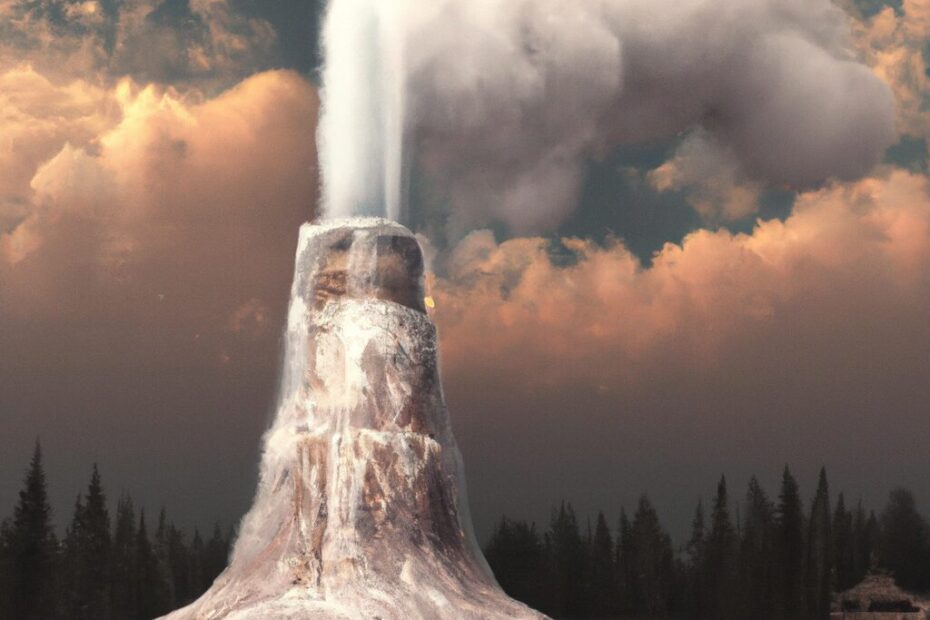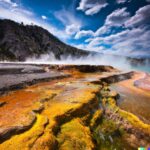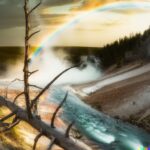Yellowstone National Park is renowned for its mesmerizing geysers, natural wonders that captivate visitors with their powerful eruptions of hot water and steam. But how did these geysers come to be known and studied?
In this article, we will delve into the early exploration of Yellowstone geysers, uncovering the first explorers who marveled at these unique phenomena and the scientific discoveries that paved the way for modern geology. Join us as we explore the remarkable history and notable geysers of Yellowstone National Park.
What is a Geyser?
A geyser is a rare geological feature typically found in regions of geothermal activity such as Yellowstone National Park.
These natural wonders are formed when underground water comes into contact with hot rocks, leading to the build-up of pressure and ultimately resulting in explosive eruptions of steam and water. Yellowstone, known for its high concentration of geysers, is home to famous attractions like Old Faithful, which regularly shoots boiling water 100 feet into the air. The geothermal activity in Yellowstone creates a unique environment where visitors can witness the power and beauty of nature’s forces at work.
Why is Yellowstone National Park known for its Geysers?
Yellowstone National Park is renowned for its geysers due to the park’s unique hydrothermal system that boasts diverse eruption patterns and fascinating geological formations.
This hydrothermal system is fueled by the immense underground heat from the Yellowstone Caldera, a supervolcano that powers the park’s geysers and hot springs. The geysers in Yellowstone are known for their varying eruption patterns, from Old Faithful’s reliable spout every 90 minutes to the unpredictable bursts of Steamboat Geyser. These eruptions showcase the dynamic nature of Yellowstone’s geothermal features, attracting visitors from around the world to witness this natural spectacle. The distinct geological formations surrounding the geysers, such as colorful mineral deposits and unique terraces, add to the park’s allure and scientific significance.
Early Exploration of Yellowstone Geysers
The early exploration of Yellowstone geysers marked a significant chapter in the history of scientific investigation, as pioneers ventured into the unknown to unravel the mysteries of these captivating geothermal phenomena.
Who were the First Explorers of Yellowstone?
The first explorers of Yellowstone, drawn by tales of mystical geysers, embarked on daring journeys to uncover the secrets hidden within the park’s geothermal wonders.
These early adventurers were captivated by the enchanting stories they heard of spouting hot springs and bubbling mud pots in the remote wilderness of Yellowstone. Motivated by a blend of scientific curiosity and a thirst for discovery, these intrepid individuals braved the rugged terrain and harsh conditions to observe firsthand the spectacular natural spectacles that lay hidden within the park. Their groundbreaking findings not only added to the world’s knowledge of geothermal activity but also sparked widespread fascination with the unique wonders of Yellowstone.
What Did Early Explorers Think of the Geysers?
Early explorers of Yellowstone were awestruck by the majestic beauty and untamed power of the geysers, sparking a curiosity that laid the foundation for future scientific study and exploration.
Their first encounters with these natural wonders stirred a sense of wonder and amazement, with some documenting their observations in journals filled with sketches and detailed descriptions. These explorers, often rugged individuals venturing into the unknown, speculated on the source of the geysers’ power, attributing them to mysterious underground forces. These early interpretations, although sometimes fantastical, set the stage for later researchers to unravel the scientific realities behind the geothermal activity in Yellowstone National Park.
Scientific Study of Yellowstone Geysers
The scientific study of Yellowstone geysers represents a pivotal exploration into the complex interplay of geological formations, hydrothermal features, and the underlying hydrogeology that powers these mesmerizing natural phenomena.
When Did Scientific Study of the Geysers Begin?
The scientific study of geysers in Yellowstone commenced in the early stages of exploration, as researchers sought to decipher the mechanisms behind these natural wonders.
One of the key milestones in the timeline of this scientific inquiry was the groundbreaking research conducted by geologist A.C. Peale in the late 1800s, who documented extensive observations on the behavior of Old Faithful, one of Yellowstone’s most famous geysers. As scientific interest grew, subsequent studies delved into the hydrothermal processes and geological factors influencing geyser eruptions, sparking a wave of curiosity about the interconnected systems that govern these captivating displays of underground energy.
What Did Early Scientists Discover about the Geysers?
Early scientists studying geysers uncovered groundbreaking insights into the geological formations, eruption patterns, and hydrothermal processes that govern the behavior of these extraordinary hydrogeological features.
Their meticulous observations revealed the intricate relationship between the internal pressure build-up and the subsequent explosive release of superheated water and steam that characterize geyser eruptions. By documenting the intervals between eruptions, the scientists noted recurring patterns that hinted at underlying geological structures responsible for the periodicity of these events. Their research shed light on how the unique combination of heat sources beneath Yellowstone supports the formation of geysers, providing valuable data for modern geothermal studies aiming to harness sustainable energy sources.
How Did the Study of Geysers Contribute to the Development of Geology?
The study of geysers played a vital role in advancing the field of geology, providing valuable insights into volcanic activity, geological processes, and the intricate hydrogeological systems that shape our planet’s landscapes.
For centuries, geysers have captured the interest of geologists and scientists due to their dynamic nature and the wealth of information they hold about the Earth’s inner workings. By studying geysers, researchers have been able to unravel the mysteries of subterranean water reservoirs, magma movement beneath the Earth’s crust, and the interactions between geothermal heat and groundwater. This knowledge has not only enhanced our understanding of volcanic eruptions but also aided in predicting volcanic activity and mitigating associated hazards.
Geyser studies have shed light on how water circulates through the Earth’s crust, influencing the shaping of landscapes and the distribution of minerals. By integrating data from geyser research, geologists have been able to piece together a more comprehensive picture of the complex processes that mold our planet, highlighting the interconnectedness of geological phenomena.
Notable Geysers in Yellowstone
Yellowstone National Park boasts several notable geysers, including the iconic Old Faithful, the majestic Grand Geyser, the powerful Steamboat Geyser, the picturesque Castle Geyser, and the enchanting Riverside Geyser.
Old Faithful
Old Faithful is one of the most famous geysers in Yellowstone, known for its reliable and frequent eruptions that showcase the park’s mesmerizing thermal features.
Its unique name stems from its predictable eruptions, which occur approximately every 90 minutes, shooting boiling water and steam skyward with impressive force. This geological marvel has a long history dating back to its discovery during the Washburn Expedition of 1870. Old Faithful stands as a testament to the dynamic geothermal activity beneath Yellowstone National Park, captivating visitors for generations with its awe-inspiring displays of nature’s raw power and beauty.
Grand Geyser
The Grand Geyser in Yellowstone captivates visitors with its spectacular eruption patterns, towering plumes of water, and impressive displays of geothermal power.
One of the unique characteristics of the Grand Geyser is its predictability, as it follows a fairly regular schedule of eruptions. Visitors can anticipate its awe-inspiring displays, reaching heights of up to 200 feet. This geyser is part of the Upper Geyser Basin, adding to its significance as it is surrounded by other notable geothermal features like Old Faithful. The intermittent eruptions of the Grand Geyser leave onlookers mesmerized, showcasing the incredible natural wonders of Yellowstone National Park.
Steamboat Geyser
Steamboat Geyser stands out in Yellowstone for its remarkable geothermal activity, towering eruptions, and unpredictable eruption patterns that showcase the dynamic nature of the park’s hydrothermal features.
Its eruptions can reach heights of over 300 feet, making it the tallest active geyser in the world. The sporadic nature of its eruptions, with periods of frequent activity followed by long intervals of dormancy, has puzzled geologists for decades. These unique eruption patterns offer insights into the complex underground plumbing systems of Yellowstone’s geothermal features, aiding researchers in understanding the underlying mechanisms that drive such powerful hydrothermal phenomena.
Visitors are not only mesmerized by the awe-inspiring displays of Steamboat Geyser but also by the enigmatic way in which it operates, reminding us of the forces at work beneath the earth’s surface.
Castle Geyser
Castle Geyser, with its unique castle-like structure, mesmerizes visitors in Yellowstone with its sporadic but visually stunning eruptions that underscore the park’s diverse hydrothermal features.
Standing majestically, the cone of Castle Geyser rises like a fairy-tale fortress against the backdrop of the park’s geothermal landscape. When Castle Geyser erupts, it unleashes a powerful surge of boiling water and steam, accompanied by a distinctive roar that echoes through the surrounding geysers and hot springs. Its eruptions are known for their impressive height and duration, often lasting up to 20 minutes. Unlike some of the more predictable geysers in Yellowstone, Castle Geyser keeps visitors on their toes with its irregular eruption patterns, adding an element of suspense to their geothermal experience.
Riverside Geyser
Riverside Geyser enchants spectators at Yellowstone with its picturesque location along the Firehole River, frequent eruptions, and scenic interactions with the surrounding geothermal vents.
Situated in the Upper Geyser Basin of Yellowstone National Park, Riverside Geyser stands as a captivating natural wonder that captivates visitors with its distinctive eruption behavior. As the geyser awakens, its spout sends a powerful jet of hot water soaring above the tree line, creating a mesmerizing spectacle along the banks of the Firehole River. The interaction with the geothermal vents beneath the surface adds to the mystique of this geological marvel, shaping its eruption patterns and drawing in curious onlookers to witness its dynamic displays.
Last Updated on February 7, 2024 by Jon Waraas – Originally Posted: February 6, 2024

I’m Jon Waraas, and I’ve been navigating the online world since 2006. By day, I’m the proud owner of some eCommerce gems, and by night, I’m the voice behind the adventures on Waraas.Com.
My heart, however, belongs to the wild beauty of Yellowstone National Park. I’ve got a collection of websites dedicated to sharing the wonders of this natural masterpiece. Oh, and did I mention? I’m currently building my own cabin inside the ghost town of Gilmore, Idaho – a cabin with tales to tell!
When I’m not immersed in the digital realm, you’ll find me lacing up my boots for a good hike or setting up camp under the star-studded sky.




